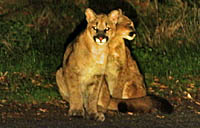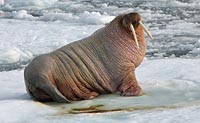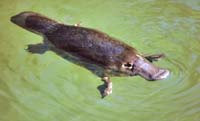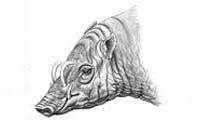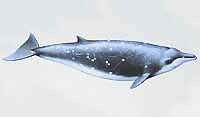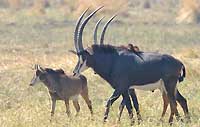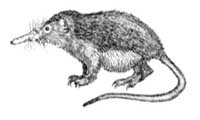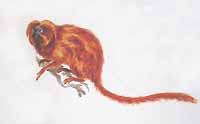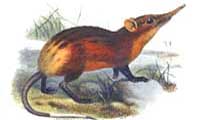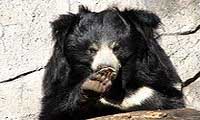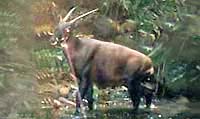# |
Species
[range] |
Photo/art [see credits]
all photos taken in wild unless stated |
Reason for choice |
DR seen? |
41 |
Brown Bear [Grizzly Bear]
Ursus arctos
[n. Holarctic] |
|
Although its range is widespread
throughout northern forests, Brown Bear – and especially Grizzly Bear U.a. horribilis of North America (left) – is a prized and wondrous beast. Watching
them catch fish during wild salmon runs was a wildlife spectacle to remember forever. |
Yes |
42 |
Puma [Cougar or
Mountain Lion]
Felis concolor
[New World] |
|
Widespread across North &
South America, this is a "ghost cat." I live
where it is common, and still have not seen one. Some say this cat is "too common" for this list but it is the epitome
of New World wilderness. Seeing this large cat would require a great deal of luck, as puma is quite shy and elusve. |
No |
| 43 |
Sperm Whale
Physeter macrocephalus
[oceans] |
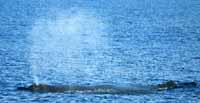 |
The largest toothed whale, it ranges the deep oceans, diving for up to an hour (recorded down to 8200' depths!). Numbers declined seriously during whaling but it is still widespread. You generally must get out over the deep ocean and then get lucky to see it. |
Yes |
44 |
Walrus
Odobenus rosmarus
[Arctic oceans] |
|
Giant tusks on the world's
largest seal make the Walrus unique and impressive. Packs live on
remote ice flows in the Arctic. Populations were over-hunted for ivory
for decades but are now making recoveries. Walrus can dive to 350' and
forage for mollusks (but not with the tusks!). |
Yes |
45 |
Platypus
Ornithorhynchus anatinus
[Australia] |
|
The Platypus is not very
large but it is very, very strange. Males have a poison spur on the
hind leg. It is aquatic and lives in burrows, coming out to forage at
night. The marsupial adaptations in Australia are impressive, but this
Monotreme is downright weird. |
Yes |
46 |
Bongo Tragelaphus eurycerus
[central Africa] |
|
The Bongo is a shy, retiring forest antelope in central Africa with an exceptionally beautiful pelage. Historically found in three fragmented areas, it is declining everywhere. It used to be regular at some mountain lodges in Kenya, but those days are gone. |
No |
47 |
Spectacled Bear
Tremarctos ornatus
[Andes of South America] |
|
Sometimes called "Andean Bear,"
this is the only native bear in South America. It is probably the
world's most endangered bear. This shy, boldly-patterned bear, named
for the buff ring around each eye, is very difficult to see in Andean
foothills or adjacent rain forest. |
No |
48 |
Babirusa
Babyrousa babyrussa
[Sulawesi] |
|
This large wild pig of tropical forests in Sulawesi and surrounding islands is rare and elusive. The male's upper tusks emerge through holes in the snout and curve back toward the forehead, producing a totally unique look. Video in David Attenborough's Life of Mammals is very impressive — it would be a treat to see it in the wild. |
|
49 |
any Mesoplodon beaked whale
Mesoplodon sp.
[oceans] |
|
Among 20+ species in family
Ziphiidae (beaked whales), 15 are in genus Mesoplodon.
Although widespread, they are very difficult to see due to their
off-shore habitat and deep-diving behavior. Considered near-mythical by
sea-going wildlife watchers, any observation is highly prized. Other
ziiphids are also very cool. |
Yes; 2 of 15 |
50 |
Sable Antelope
Hippotragus niger
[e. & s. Africa] |
|
This might be the most impressive of all antelope. It is found in
some parks in east & southern Africa without huge effort, but at
others (e.g., Kruger NP) it can be elusive. I've wanted to see it ever
since staring at natural history dioramas with stuffed Sables in San
Francisco & New York as a kid. So this is a personal choice; some "close contenders" are rarer or more difficult. |
Yes |


